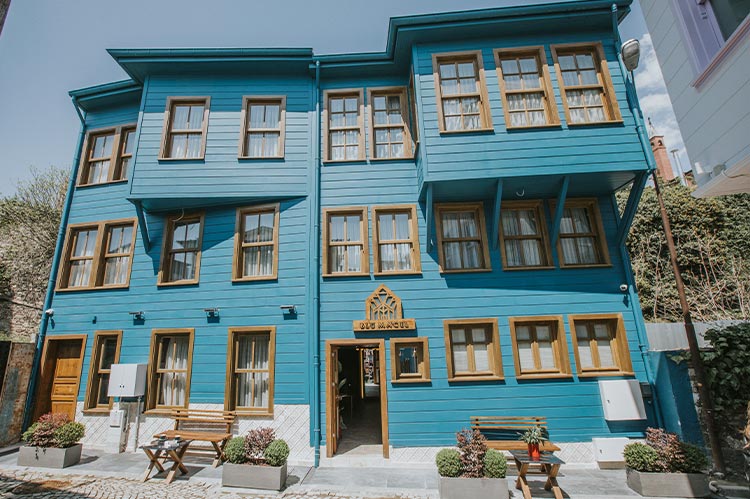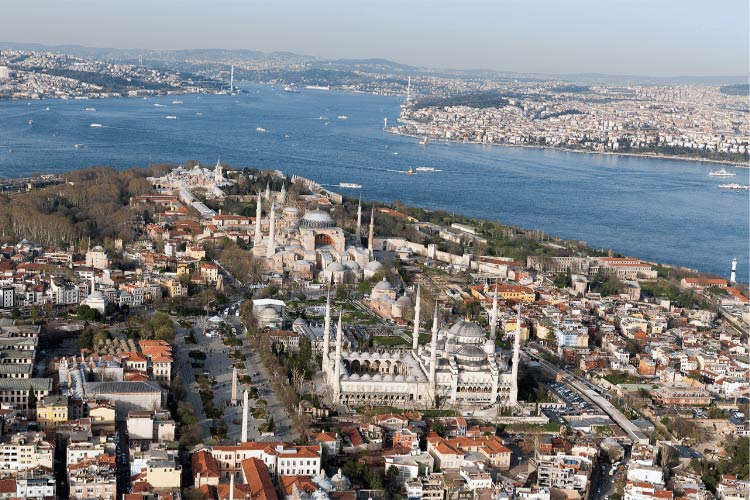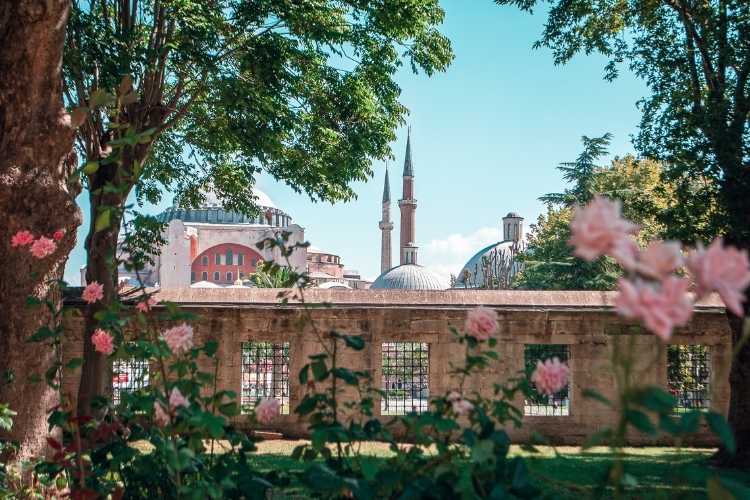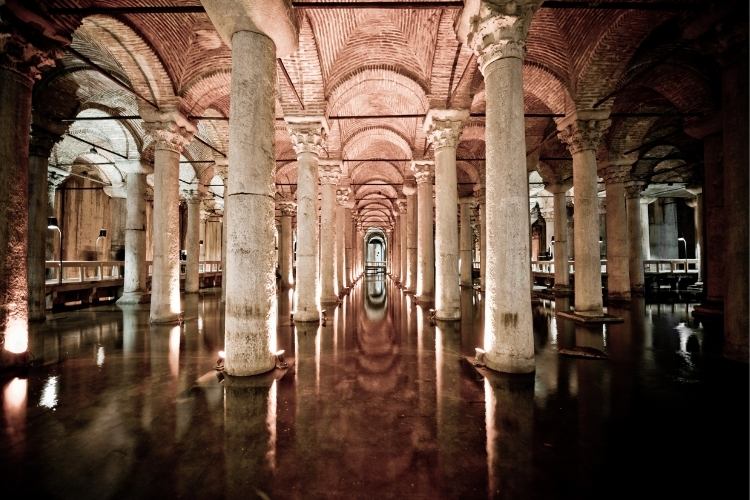
Journey with us as we delve into the depths of Sultanahmet's mysterious wonder, the Basilica Cistern. This subterranean marvel, known in Turkish as "Yerebatan Sarnıcı", captivates visitors with its grandeur, history, and the sheer beauty of its age-old columns.
Beyond the bustling streets of Istanbul, beneath the historic Sultanahmet district, lies an ancient marvel that resonates with tales of the Byzantine era. As you descend into its cool, hallowed depths, the city's noises fade, replaced by the soft echoes of dripping water and hushed voices. This is the Basilica Cistern, Istanbul's subterranean treasure. A testament to the brilliance of ancient architecture and a window into the city's rich history, this vast underground chamber invites explorers to wander its shadowy columns and discover its many legends.
A Historical Overview
The Basilica Cistern, stands as a marvel of Byzantine engineering from the 6th century. Constructed during Emperor Justinian I's reign, this underground reservoir, built over an older basilica, provided water to the Great Palace and surrounding edifices. Today, it symbolizes Istanbul's rich and layered past, bridging centuries of history and civilization.
The Origins of the Basilica Cistern
The Basilica Cistern, known locally as "Yerebatan Sarnıcı" (meaning “Sunken Cistern”), is an emblem of Byzantine engineering. Its origins trace back to the 6th century AD, during the reign of the Byzantine Emperor Justinian I. It was constructed between 532 and 536 to address the city's increasing water needs, ensuring Constantinople had a reliable and ample water supply, especially during siege or drought.
Before the cistern's construction, a great basilica stood in its place, hence the name "Basilica Cistern." This basilica was an essential center of commerce, art, and culture in Constantinople for nearly a century. The cistern was built by repurposing the ruins and vast columns of this basilica, giving the reservoir not only its iconic structural appearance but also its name.
Its strategic importance cannot be understated. Byzantine engineers designed this cavernous reservoir to store up to 80,000 cubic meters of water. Water was channeled into the cistern from the Belgrade Forest, nearly 20 kilometers away, through the ancient aqueducts of Valens and Maglova. Such a system provided a safeguard for the city's inhabitants during the many instances when the great city of Constantinople was under threat.
Over the years, the cistern served not just as a water reservoir but also as a reflection of the Byzantine Empire's resilience, innovation, and grandeur. Its grand scale and intricate detailing showcase the advanced engineering and artistic capabilities of a civilization that stood at the crossroads of the East and West for over a millennium.
A Byzantine Marvel
While many cisterns dot Istanbul, the Basilica Cistern stands out with its sheer size. With the capacity to hold 80,000 cubic meters of water, it was a true feat of Byzantine engineering. The 336 marble columns arranged in 12 rows support the cistern's roof, each standing 9 meters tall.
Architectural Splendor
The Basilica Cistern is an architectural masterpiece, boasting 336 marble columns arranged in 12 rows, each standing 9 meters tall. These columns support vast arches, creating an atmospheric maze that visitors can wander through. The symmetrical and geometrical layout of the cistern, combined with its dim lighting and the sound of dripping water, offers a surreal experience.
Beyond its sheer size, the choice of materials and the craftsmanship evident in every corner speak to the meticulous attention to detail and the grand vision of Byzantine builders. The cistern is not just a functional infrastructure; it's a work of art, illustrating the zenith of architectural achievement during its time.
Medusa Heads: The Enigma Below
Nestled among the 336 columns of the Basilica Cistern are two particularly mesmerizing relics: the Medusa heads. Serving as the base for two columns in the northwest corner, these intricately carved stone heads of the Gorgon Medusa add a touch of myth and intrigue to the cistern. Their origin and the reason for their placement remain shrouded in mystery. Were they repurposed from a Roman building, or were they specially commissioned for the cistern?
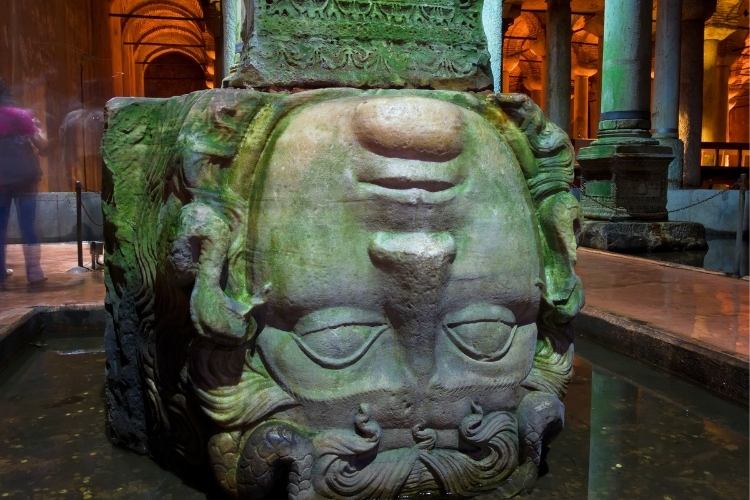
An additional layer of intrigue is the positioning of the heads. One is placed sideways while the other is upside down, leading to various speculations. Some historians believe this deliberate positioning was meant to neutralize the Medusa's petrifying gaze, while others argue it might simply have been an aesthetic choice or the result of the stonemasons' limited understanding of the myth. Theories also extend into the spiritual realm, with suggestions that the inverted positions symbolize the ancient world's transition from pagan beliefs to Christianity. Amidst the cistern's still waters and dimly lit ambiance, these enigmatic heads continue to captivate visitors, encouraging them to ponder over the tales and secrets the ancient city holds deep within its bowels.
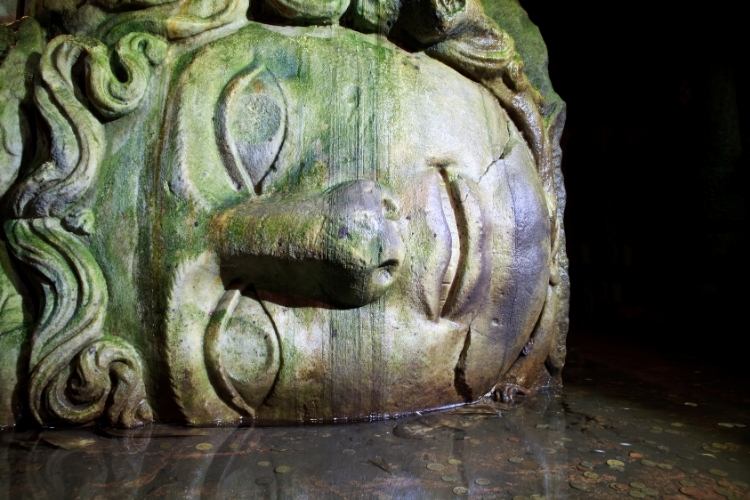
The Symmetry and the Design
The columns, most of which were salvaged from ruined temples, showcase diverse styles, primarily Ionic, Corinthian, and Doric. The cistern's symmetry combined with the constant dripping of water creates an eerily beautiful atmosphere, reminiscent of a sunken palace.
Experiencing the Cistern Today
Visiting the Basilica Cistern today is like stepping into another world, far removed from the bustling streets of modern-day Istanbul. As you descend into the subterranean depths, the cool air and soft echoing sounds transport you back to ancient times. Strategically placed lights illuminate the columns, casting mesmerizing reflections onto the water's surface.
The serene ambiance is occasionally punctuated by the whispers of awed visitors and the gentle droplets of water. As you navigate the raised wooden platforms, every turn provides a new perspective, ensuring that each visit feels unique. It's a testament to how ancient engineering can continue to captivate contemporary audiences.
A Modern-day Attraction
In the hustle and bustle of modern Istanbul, the Basilica Cistern stands as a serene escape, offering a tranquil journey back through the annals of history. Today, it attracts millions of tourists annually, not only for its historical significance but also for the unparalleled experience it provides. The combination of gentle lighting reflecting off the water, the sound of dripping water echoing softly, and the majesty of its architecture transports visitors to a bygone era, making it a must-visit for anyone traversing the streets of Istanbul.
Furthermore, the cistern has found its way into contemporary pop culture, serving as a backdrop for various films and literature. Notably, it was featured in the James Bond movie "From Russia with Love," adding a touch of cinematic allure to its reputation. Additionally, local and international artists often hold concerts and events within its walls, utilizing the cistern's exceptional acoustics to create mesmerizing performances. The Basilica Cistern, thus, seamlessly marries the past with the present, ensuring it remains a relevant and enchanting destination in the heart of Istanbul.
Cultural Events and Concerts
Occasionally, the cistern plays host to cultural events, music concerts, and art exhibitions, which when combined with its haunting acoustics, makes for a mesmerizing experience.
The Basilica Cistern isn't just a relic of the past; it's a living testament to the grandeur and vision of Byzantine architecture and engineering. As you walk its dimly lit corridors, you're not just exploring a historical site; you're stepping back in time, feeling the weight of centuries and the echo of a civilization that once was. Don't miss this unparalleled experience when you visit Istanbul.




